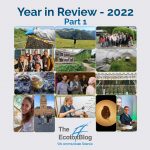In the first part of the ‘Glimpse of the year 2022’ series, we give our readers a glance of 3 most visited posts about scientific publications in this year.
Continue readingGlimpse of 2022 (Part 1)



In the first part of the ‘Glimpse of the year 2022’ series, we give our readers a glance of 3 most visited posts about scientific publications in this year.
Continue reading
How climate change will alter the effects of toxicants is a key concern in the 21st Century. Rising water temperature can increase the toxicity of some contaminants to stream-dwelling animals in laboratory conditions, as has been shown for the most widely used insecticides in the world – the neonicotinoids. But until this study, whether this translates to more realistic environmental scenarios remained to be tested. In this blogpost, Sam Macaulay talks about his mesocosm experiment studying the effects of rising water temperatures and neonicotinoids on stream invertebrate communities.
Continue reading
In this blogpost, Francesco Polazzo talks about how pesticides can cause a drastic change in the organisation and strength of interactions of aquatic food webs. Particularly, after pesticide exposure, changes in the strength of trophic interactions seem to be driving long-lasting effects in community structure. When multiple pesticides act together, they modify both food web structure and interaction’s strength, causing late-stage non-additive effects between stressors.
Continue reading